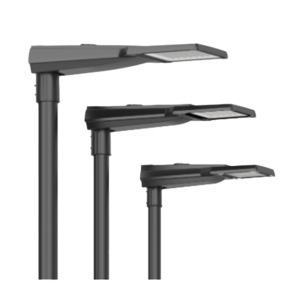Road Lighting Control System
Table of Contents
Introduction of smart street lighting
As urbanization accelerates, street lighting has gained increasing attention as a reflection of a city’s image. Within the street lighting system, addressing energy conservation, improving street lamp energy efficiency, and implementing smart street lighting controls have become urgent challenges.
Traditional street light control methods exhibit several pain points:
- High Energy Consumption
- Traditional street lamps consume significant energy.
- Unintelligent management leads to substantial energy wastage.
- High Operating Expenses (OPEX)
- Inability to adjust lighting in real-time according to actual conditions, hindering precise management.
- Lack of visual energy consumption data.
- Real-time failure detection is absent.
- Maintenance labor costs are high.
- Resource Waste
- Street lights remain on or cannot be dimmed during unoccupied hours.
- Separate installation of various smart sensors on different light poles leads to resource dispersion.
- Poor User Experience
- Street lights cannot automatically adjust based on space brightness.
- Inability to adapt to actual weather conditions impacts citizen safety.
These shortcomings render traditional street lamp control methods ineffective for centralized monitoring, recording, and statistics, failing to meet quantitative management requirements. Inspection and maintenance are inconvenient, unsuitable for urban modernization. This has spurred the rise of smart street lighting systems aimed at addressing these challenges.
Costs for municipalities
At the local and municipal level, public authorities are responsible for providing street lighting as a critical public service to ensure citizens’ safety. However, this service represents a significant cost for local governments, posing challenges in terms of affordability and sustainability. Additionally, many municipalities continue to rely on outdated and inefficient street lighting infrastructure, resulting in higher energy consumption and increased maintenance expenses. An obsolete lighting system can contribute to as much as 50% of a typical city’s total energy bill.
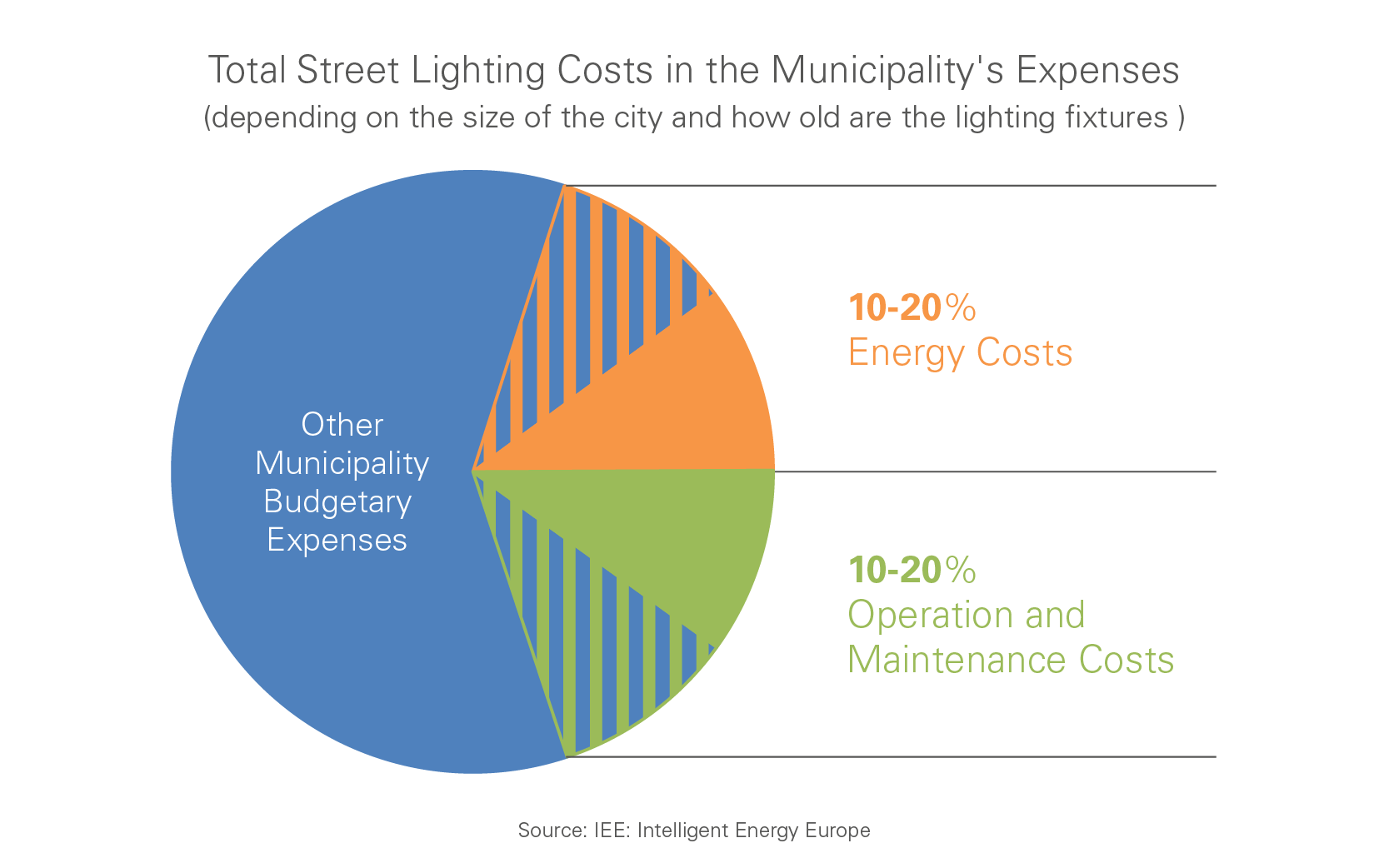
Levels of interaction for streetlight solutions
Information plays a crucial role in modern cities, often considered more important than direct energy savings. City managers prioritize access to solid data, whether it pertains to street lighting functionality and electrical parameters or broader city metrics such as pollution levels. This information is essential for optimizing city processes and operations effectively.
The operational aspects of street lighting are closely linked to functionality and maintenance. Basic functions like on/off and dimming are fundamental in any connected lighting system. Autonomous operation, adaptive lighting, and maintenance optimization further enhance the capabilities of smart street lighting solutions.
Optimization relies on information but should not be mistaken for it. It represents a distinct process aimed at maximizing efficiency and effectiveness. Ignoring the benefits of optimization could render valuable information ineffective. This ongoing pursuit can leverage city-wide infrastructure, such as intelligent lighting networks.
Integration is key to achieving synergy. While individual smart systems like lighting, traffic control, waste disposal, and utilities are beneficial on their own, their true potential is realized through integration. Cities seek holistic improvements across systems to achieve synergistic benefits. Recent studies highlight that smart systems open to integration are leading the charge in the Smart City revolution.
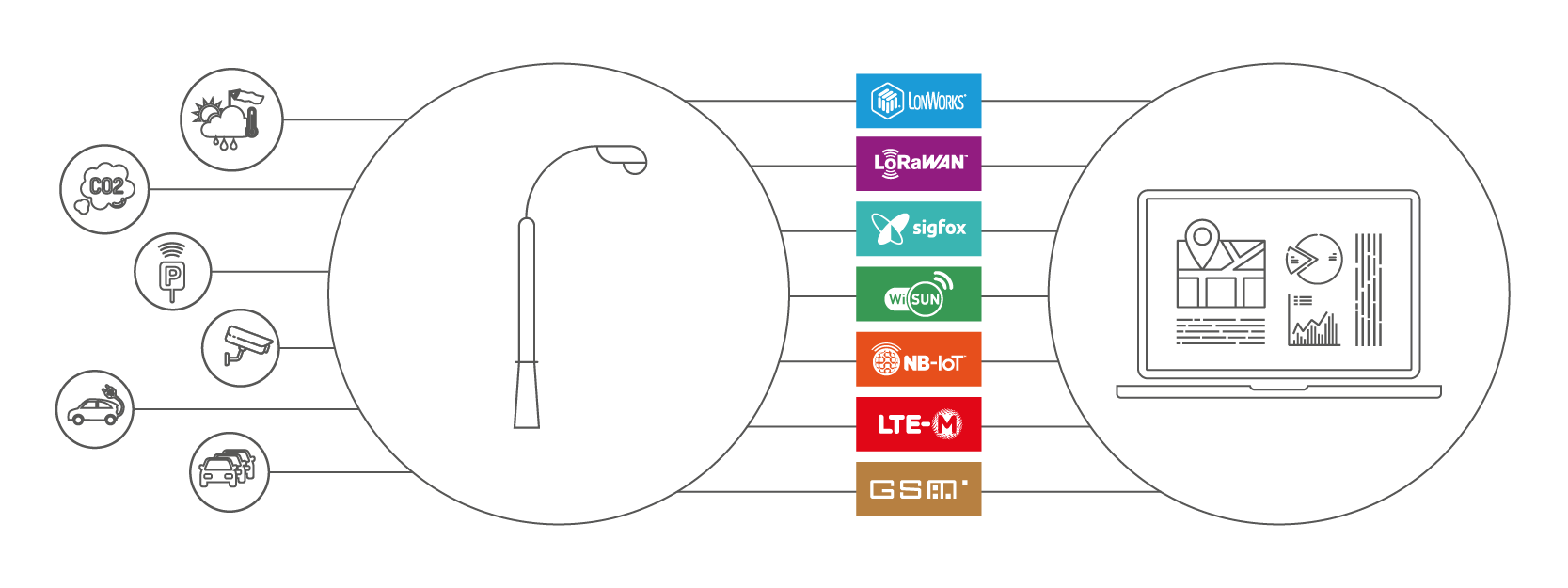
Smart street lighting control systems
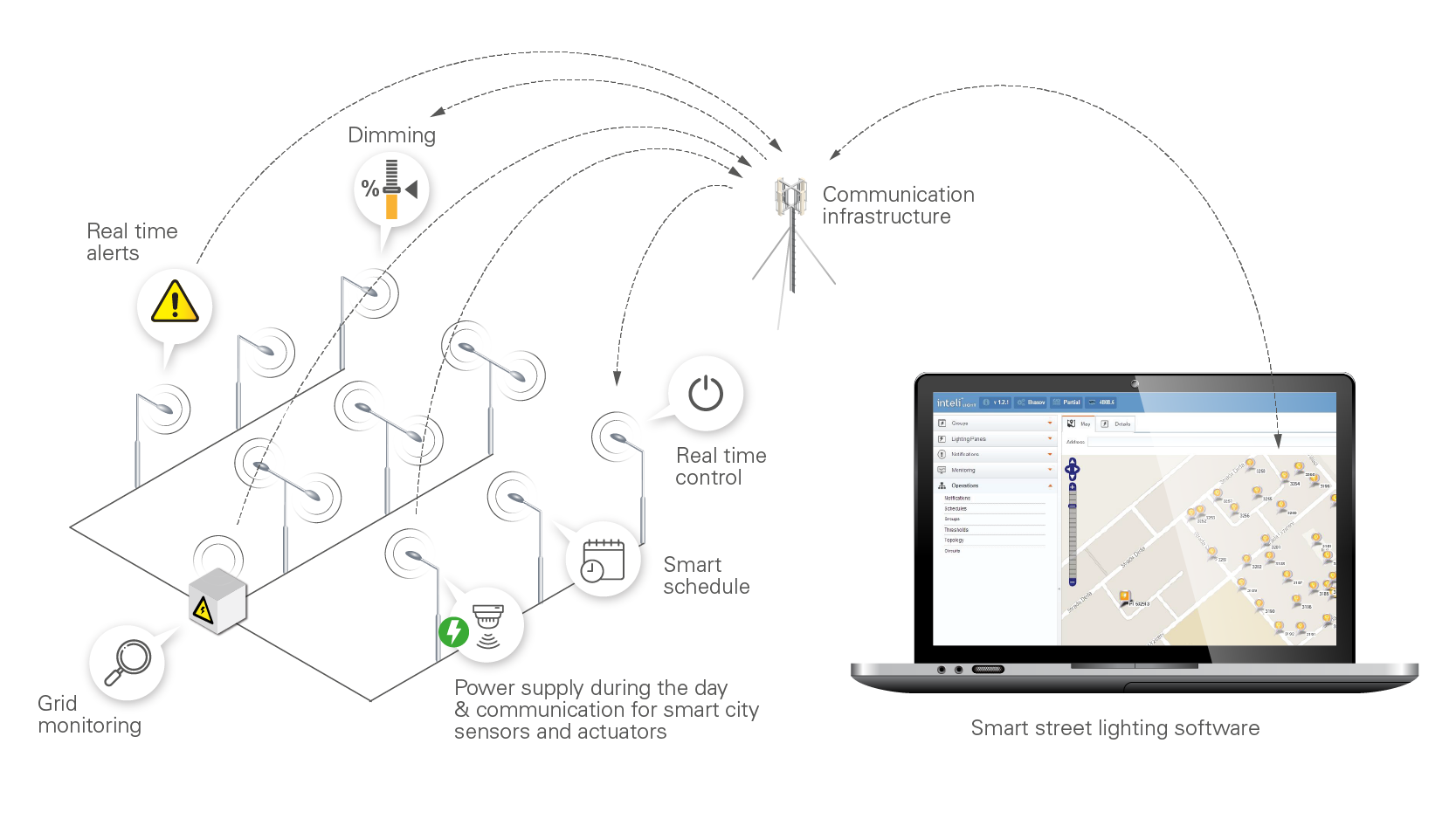
The concept of street lighting control emerged long ago as a response to the challenges associated with managing large numbers of lamps efficiently. The need arose to cluster lamps into smaller groups and handle them more effectively for powering on and off, managing power outages, and conducting maintenance. This led to the invention and use of lighting panel control and monitoring units such as power cabinets and feeder pillars to restructure public lighting. These units enabled manual control of each light segment. Subsequently, controllers were integrated into these lighting control units, replacing human intervention and automating the process of switching lights on and off.
Over time, street lighting has needed to become more efficient, consume less energy, and reduce pollution. Control systems have evolved into ‘smart’ systems that enable lamp control and data collection. This evolution has facilitated segment-level and lamp-level control through cabinet or luminaire controllers, respectively.
Street lighting control levels
A smart street lighting system controlled at the segment level typically consists of a cluster of up to 200 streetlight lamps that communicate with a power cabinet enabling automatic on/off control. The feeder pillar receives data from these lamps, manages it, and transmits relevant information to a secure server, where it is stored and displayed on a dashboard for monitoring and analysis.
For individual lamp control, luminaire controllers are employed, offering lamp-level functionality and intelligence. These controllers enable on/off/dimming control or adaptive lighting strategies for each lamp. Additionally, luminaire controllers provide feedback on electrical parameters for every lamp, facilitate real-time malfunction reporting, and can incorporate optional sensors to measure light levels, motion, temperature, humidity, noise, and other environmental factors. Moreover, lamp-level control ensures that the lighting grid remains operational during the day, allowing for the integration of other smart city applications such as sensors, controllers, CCTV cameras, or communication devices onto the same infrastructure.
Lamp control standards, sensors and adaptive lighting
The main standards for lamp control include 0-10V, DALI-1, and DALI-2 (Digital Addressable Lighting Interface). It is crucial to ensure that smart lighting controllers are compatible with the specific control system used by the lamps.
Moreover, certain lighting controllers support additional connectivity options. Special sensors can be integrated into the system to enable specific lighting control features or to incorporate unrelated sensors. An example of this is adaptive lighting, where lamps can be dimmed in real time upon detecting presence such as pedestrians or vehicles. Implementing adaptive lighting typically involves adding a motion sensor to the lighting pole, which is then directly connected to the lighting controller.
Smart street lighting controller types, form factors and mounting options

Main types of controller installation available
- On-lamp socket installation: it’s by far the fastest way to get smart street lighting. Most lamps today come with a NEMA or Zhaga socket option, which allows almost plug-and-play installation. The NEMA socket (ANSI C136.41) is a street lighting connector derived from the American socket standard that has expanded worldwide. Zhaga is a newer, more compact connector that aims to take over the streets, developed especially for today’s slim LED fixtures.
- Embedded controllers: compact controllers to be installed inside the lamp, sometimes right from the production line. It’s the best way to keep the lamp’s architectural value intact, while offering added value for lamp manufacturers.
- Pole-Mounted controllers: mounted inside or on the lighting pole, it is the most flexible option for smart street lighting projects. Even if it is more complicated to install (it usually needs custom mounting and direct wire connection) and more expensive (their design needs to be resistant to weather – usually IP66), it is the most flexible option available, as it does not require any special connections or certain lamp types. It connects directly, so it can be used to retrofit existing street lighting installations with minimal visual impact and virtually no civil works.
Communication technology

Communication networks can cover various ranges, depending on the distance at which nodes can communicate with other nodes and gateways.
Powerline Communication
Wired or Powerline Communication (PLC) functions over long distances by transmitting a communication signal directly onto power lines. The continuous conductors facilitate uninterrupted communication, and the PLC signal typically does not pass through transformers or other power conditioning devices. LonWorks® (by Echelon), for example, is a robust power-line communication technology used in advanced streetlight systems.
In street lighting applications, groups of streetlights often share a common powerline. These streetlights can either communicate with each other or communicate with gateways that connect to supervisory control systems.
Gateways play a crucial role in synchronizing communication between up to 200 lighting controllers and the lighting control software. Through wireless connections, an IoT gateway receives, filters, and forwards messages from the controllers to the management platform for analysis.
Radio Frequency (RF) Communication
Radio Frequency (RF) communication in street lighting systems addresses many of the limitations of powerline communication. While most smart street lighting systems operate similarly, there are various methods for exchanging data between connected smart streetlights and the Central Management System (CMS). These methods include cellular networks (2G, 3G, LTE, 5G, NB-IoT), RF mesh, LoRa, Wi-Fi, and other medium- to long-range solutions. You can read a comparison of the main cellular networks here.
Short-range networks like RF mesh have a maximum node-to-node distance of 200-300 meters and can support around 200 devices, with streetlights spaced approximately 50 meters apart. Short-range networks are suitable for urban areas where lamps are installed closer together, reducing the distance messages need to travel. However, setting up an RF mesh network requires meticulous initial network planning, considering node density and gateway placement, which can increase deployment costs. Nonetheless, operating costs for an RF mesh network are significantly lower compared to a cellular network because there are no data charges.
Streetlight remote control software
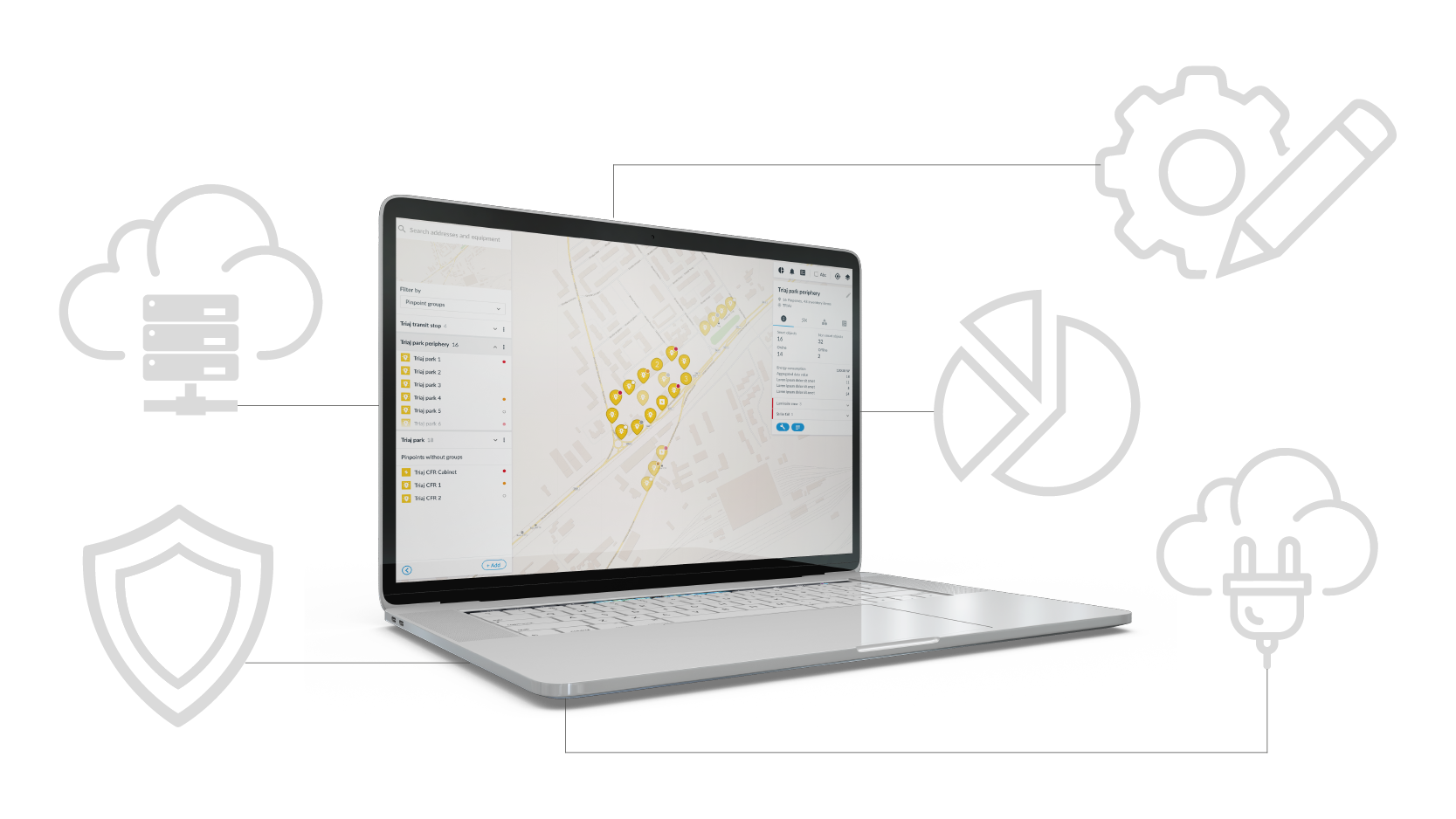
Modern smart lighting control systems integrate software and hardware components to enable local governments to efficiently manage large-scale public lighting networks. These systems facilitate bidirectional communication, allowing remote control of lamps while also collecting, storing, displaying, and analyzing data within the software application. Additionally, system failure alerts enable municipalities to respond promptly and effectively.
When selecting lighting control software, it is crucial to ensure that the solution meets your specific requirements. However, it’s important to recognize that the effectiveness of a smart lighting management software is not solely dependent on its functionalities. The choice of communication technology and hardware type deployed also significantly influences system efficiency.
Aspects to assess when choosing a smart lighting control software
- Does the software have basic control options (on/off) or does it support dimming and adaptive lighting functionalities?
- Does the system provide in-depth grid awareness (detailed information and inventory features)? How many parameters can the system manage and is it a fixed list or is it flexible (create new parameters)?
- Is the software secure? Does it use the latest data encryption technology and VPN?
- Is the reporting functionality organized to help you optimize your street lighting/smart city system?
- How does ticketing and notification work? Is there user-level access control and a default daily notification systems, so you can deploy maintenance teams automatically?
- Can the company customize the software to fully adapt to your local needs? E.g. specific integrations, translation and localization
- Is the software designed to be integrated with other smart devices and sensors? Does it allow north-bound and south-bound API integrations and is it compatible with major standards such as TALQ?
- If having a closed system is important to you, can the system be deployed on a local computer (standalone installation) and managed within a closed circuit? Or is it available only as a SAAS (cloud service, usually allowing for more flexibility and automatic updates)?
By using an open architecture, a streetlight control software can be effortlessly integrated with third party systems, IoT applications and devices. Moreover, certified standards such as TALQ lead to a vendor-neutral ecosystem and promotes solution interoperability. This represents a solid first step towards developing a sophisticated, truly open smart city platform.
IoT integration and Smart Cities of the future

What’s next?
The future of smart street lighting appears to be moving towards repurposing existing infrastructure and embracing full interconnectivity on the IoT platform. This trend is enabling the deployment of various solutions alongside modern intelligent street lighting systems, including electric vehicle charging stations, smart parking, public safety video monitoring, traffic management, broadband connectivity, and more.
Smart street lighting is envisioned as the foundation for future smart cities, linking over 360 million streetlights globally into a unified, centrally controlled network. With constant access to power, street poles offer an ideal platform for integrating diverse smart city systems such as security cameras, environmental sensors, traffic counters, and electric vehicle chargers. By connecting each lighting pole to a broader network, every lamp becomes an IoT-ready installation platform, facilitating broader smart city investments and innovations. This integration transforms city infrastructure into a cohesive ecosystem that enhances efficiency, sustainability, and citizen well-being.

